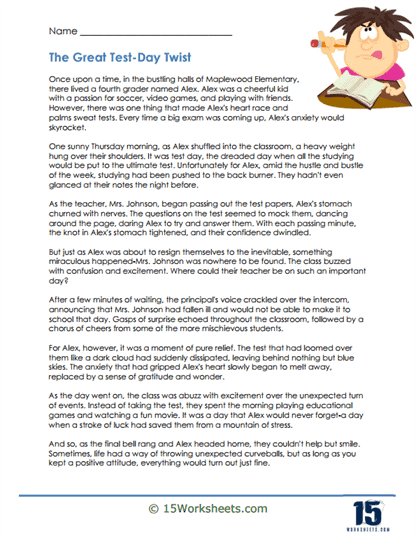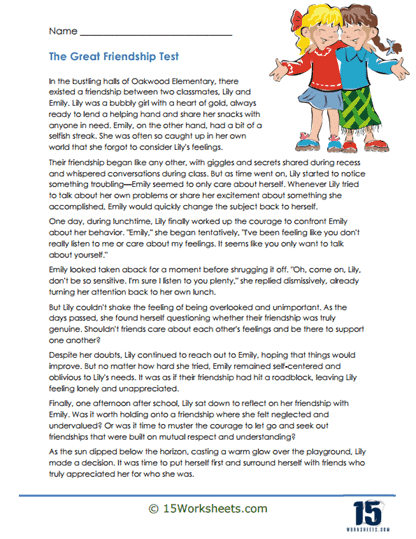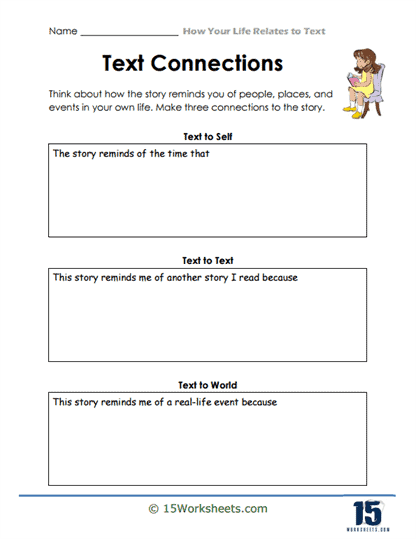How Your Life Relates to Text Worksheets
About These 15 Worksheets
These worksheets are designed to facilitate connections between students’ personal experiences and the texts they read, whether those texts are literary works, historical documents, or contemporary articles. The main objective of these worksheets is to enhance students’ reading comprehension and engagement by drawing parallels between their own lives and the events, characters, or themes presented in a text.
By incorporating personal reflections, character analysis, thematic exploration, contextual comparison, and plot connections, these worksheets offer a multifaceted approach to reading comprehension. Through consistent practice, students not only enhance their understanding of the texts they read but also develop essential skills that will serve them well in all areas of learning.
There are several types of exercises you might find on “How Your Life Relates to Text Worksheets,” each aiming to deepen the reader’s understanding and personal connection to the material.
Text-to-Self Connection Exercises
These exercises encourage students to reflect on parts of the text that resonate with their own experiences. For instance, a worksheet may ask, “Describe a moment in the story that reminded you of something in your life. Why did it feel significant?” This type of reflection not only improves comprehension but also helps students to see the relevance of the text in the real world.
Character Comparison Activities
Students are prompted to compare themselves to a character in the text. Questions like “Which character do you most relate to and why?” or “Describe a decision a character made that you agree or disagree with. What would you have done differently?” These activities help students develop empathy and a deeper understanding of character motivations and challenges.
Theme Analysis Tasks
Students analyze the themes of the text and relate them to broader life lessons or personal beliefs. A worksheet might ask, “What is the main theme of the story, and how does it apply to your life?” This encourages students to think critically about the text and its implications beyond the story itself.
Setting and Context Challenges
These tasks ask students to consider the setting of the story and compare or contrast it with their environment. For example, “How does the setting of the story differ from your community? What would be different if it took place in your hometown?” This exercise enhances students’ abilities to understand the significance of setting in a narrative and its impact on the characters’ lives. Students can draw on the plot and relate it to events they have witnessed or experienced. Questions like, “Have you ever experienced a similar event to what happened in the story? How did it make you feel?” help students to connect more deeply with the narrative arc of the text.
Vocabulary and Language Skills Improvement
As students articulate their connections to the text, they naturally improve their vocabulary and language skills. Describing their experiences and opinions in writing encourages them to find precise words and phrases, improving their linguistic abilities.
Practicing with these worksheets can significantly improve students’ reading skills in several ways:
Enhanced Engagement
When students make personal connections with the text, their engagement with the material naturally increases. They are more likely to be interested in a story if they can see parts of themselves in it or relate it to their world. By relating their own experiences to the text, students can better understand complex themes, character development, and plot progression. This personal investment often leads to a deeper understanding of the material.
Critical Thinking Development
These worksheets encourage students to think critically about the text and their lives. They must analyze the material, synthesize information, and evaluate their thoughts and feelings in response to the text.
Empathy and Perspective-Taking
By considering different characters’ perspectives and comparing them to their own, students learn to understand and empathize with others. This can lead to a greater understanding of diverse life experiences and viewpoints. As students explain their connections to the text, they practice organizing their thoughts and expressing them clearly in writing, thereby improving their overall writing skills.
Memory and Recall Improvement
The act of connecting personal experiences to reading material can help with memory retention. Students are more likely to remember a story if they have related it to something meaningful in their own lives.

















